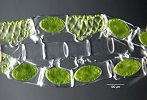
Two filaments lie parallel, and outgrowths from each filament
grow towards each other, then fuse to form a conjugation tube.
The cell in the centre of the lower filament is forming conjugation tubes
with two other cells: only one of these will fuse successfully, allowing
the contents of one cell to transfer to the other.

The dark oval shapes are diploid zygospores, formed after
nuclear fusion between the two haploid cells. They form in only one of
the two filaments.
Sometimes more than two filaments take part in conjugation:
see this 'menage a trois'

Note that the centre filament has no zygospores: it appears
to have donated all the contents of participating cells to the other filaments.
See also the two cells in the upper filament which have not succeeded
in conjugating: their tubes have not fused with the cell they contacted,
as a cell from another filament got there first.
The zygospores are green when seen in dark-ground illumination:


